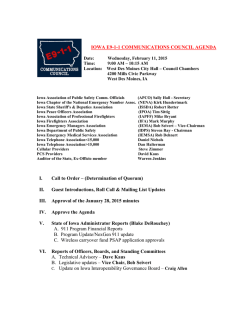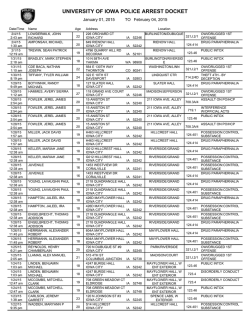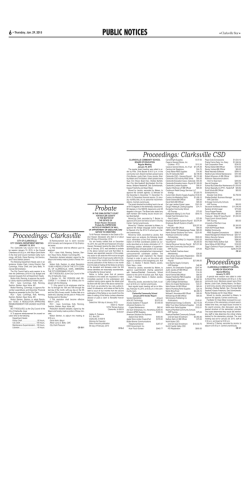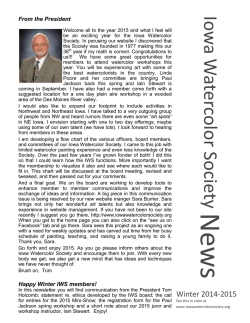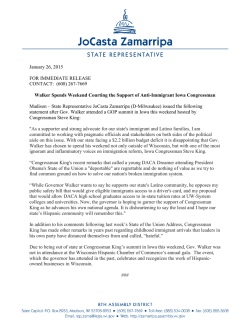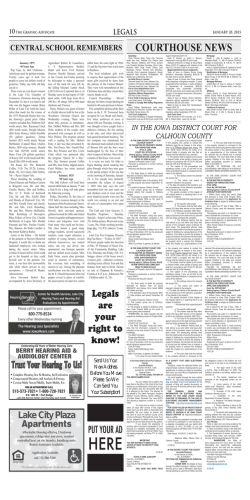
Caucus Newsletter 1-29-2015
Thursday, January 29, 2015 www.IowaHouseRepublicans.com Inside this issue: House Republican Talking Points 2015-16 House Republican Budget Principles House Republicans are committed to these principles to produce a balanced and sustainable state budget: We will spend less than the state collects; We will not use one-time money to fund on-going needs; We will not balance the budget by intentionally underfunding programs; and We will return unused tax dollars to Iowa’s taxpayers. Governor Branstad’s Budget Proposal For FY 2017, the Governor is proposing a General Fund budget of $7.5252 billion. This would be an increase of $184.2 million or 2.50 percent. 90 percent of Iowa’s budget goes to three areas - School aid ($2.9 billion), wages and benefits for state employees ($2.1 billion), and Medicaid ($1.6 billion). tion’s Allocation Summary documents, Iowa will spend $10,231 per student in FY 15. That means in classroom of 20, Iowa spends just over $200,000. Appropriations 2 Agriculture 2 If we adopted the 6% increase in supplemental state aid for education pushed by Democrats in FY 16, the state would spend 104.4% of on-going revenue. Commerce 3 Economic Growth 4 If the Legislature approved the 6% increase in supplemental state aid for education pushed by Democrats, revenue growth in FY 16 would need to be about 8.63%. Add the FY 2016 funding for the Education Reform package, and revenue growth would need to be 9.54%. Over the last 20 years, revenue growth has averaged 3.27%. Education 4 Environmental Protection 6 Human Resources 6 Judiciary 7 Or, if 6% Supplemental State Aid is approved, $316.7 million would need to be cut to balance spending with on-going revenue. That’s like not funding both the University of Iowa and the University of Northern Iowa or shifting the cost of Iowa’s mental health system to property taxpayers. Labor 7 Natural Resources 8 Public Safety 8 Transportation 8 Veterans Affairs 9 Ways and Means 9 Statistics that show Iowa is in 35th place Over the past decade, state revenue has nationally in regards to per-pupil spending are questionable. Notably that rankgrown by 4.1 percent annually, state spending on K-12 education grew by 4.2 ing comes from the NEA and its inherent percent, and Medicaid grew by 11.7 per- union biases. The US Dept. of Education’s National Center for Educational cent. Statistics shows Iowa in 28th place. 55 percent of the Governor’s FY 2016 budget proposal is targeted to education. The result of increasing state spending to unsustainable levels and spending onetime money for ongoing expenses mixed School Funding with an economic collapse caused eduHF 80 continues the legislature’s trend of cation funding in this state to take a $530 million loss in one single year (FY 2010). providing significant increases to the state’s K-12 system, bringing the 5 year The state is still recovering from that loss. That recovery is only possible if we total increase to over $570 million, a spend less than we collect. nearly 22% increase. According to the Department of Educa- If you use the 35th in the nation ranking (Continued on page 2) Page 2 House Republican Newsletter ment Payment (PTRP) of $5.6 million in the bill arguing that money could have gone to of per-pupil spending and the dollars asso- education instead of property taxpayers. ciated with it, Iowa taxpayers would need to 15 House Democrats still voted for it. back over $767 million in additional spending this year to the national average. IoDepending on the calculations you are uswans would face a 20.55% income tax ining Iowa is spending about $10,231 per crease to support this level of spending. pupil. The continued emphasis on this For a family of four, it would mean an indollar amount further cements the focus on come tax increase of $979. inputs rather than outputs. The true evaluation of K-12 performance is outputs. Or in If Iowa wanted to be in the top 10 in per other words, the academic performance of pupil spending, Iowa taxpayers would need our students. In the end, whether you to pony up over $2.8 BILLION in additional agree with a program’s purpose or not, spending. Iowans would face a 76.82% programs are supposed to help people, not income tax increase to support this level of bureaucracies. The focus on inputs is a spending. For a family of four, it would focus on bureaucracies. mean a $3,654 income tax increase. During debate on HF 80, House Democrats According to a Friedman Foundation for suggested raising business taxes and usEducational Choice study in 2013, 66% of ing money originally targeted for debt reIowans do not think per-pupil spending is duction to increase spending on education. too low and 65% believe the public school system is either good or excellent. Medicaid (Continued from page 1) Some House Democrats complained about To address the continual growth in Medithe inclusion of the Property Tax Replace- caid, the Governor is proposing major re- Appropriations forms. He expands the use of managed care in Medicaid and other cost containment initiatives, lowering state expenditures by $70.2 million in FY 2016. The Governor funds the rebasing of Medicaid rates for hospitals, nursing homes, and home health agencies. The Governor is not recommending a supplemental appropriation for Medicaid in FY 2015. Medicaid is the second biggest program in state government, and without major reform it will continue take funding away from other priorities like schools. Medicaid was 9% of the state budget in FY 2000. Today it is over 20%. While many are focused on targeting more money to schools, Medicaid is a looming issue that cannot be ignored. Over the past ten years, state revenue has grown by an average of 4.1%. School aid during this time grew at 4.2% annually. While Medicaid had an annual growth rate of 11.7%. The growth of Medicaid is crowding out other areas of the budget within the debate for additional resources. (Contact Brad Trow at 1-3471) Board of Regents Discuss Variety of Topics Continuing the efforts to better educate members on the major budget issues facing Iowa, the House Appropriations Committee had a marathon session with the Iowa Board of Regents and the state’s three universities on Monday. The main topic discussed was the Regents’ proposal to change how state funding to the three universities is distributed. Instead of maintaining the current process of simply adding a certain percentage to the current budget (a process that dates back at least to World War II), the Board establishes a formula focusing primarily on the enrollment of in-state kids. Members from both parties had substantive questions about the new formula and its impact, with House Democrats repeatedly stating the proposal sent a negative message on the importance of getting out-of-state kids to come get their degree in Iowa. The Board’s proposal for a third straight year with a tuition freeze for in-state undergrad students also engendered strong conversation in the committee. Members expressed concerns about the continued rising tuition for graduate students. The Regents also got the message that many parents have issues with rising student fees. such a deal, which does not share the $1 million with Johnson County or the Iowa City School District. Representatives of the Board reported that the Regents had implemented a policy to address these situations in the future. The impression left with committee members and others was that such a deal would not happen again. Another issue that generated a high level of discussion was the Payment in Lieu of Tax “issues with rising made by the University of Iowa Hospitals and Clinics to the city of Coralville. This student fees” arrangement was part of a deal made for UIHC to construct a major clinic facility at the Iowa River Landing development. In exchange for permission to build on the land, the hospital agreed to pay Coralville The House Appropriations Committee will $1 million annually to offset lost property tax continue inquiring into the major budget dollars. issues next week, with a discussion on the spike in costs of the state employee health Members from both parties expressed their insurance plan. displeasure to the University for agreeing to Agriculture (Contact Lew Olson at 1-3096) House Agriculture Committee’s Regulatory Review Subcommittee Meets On Tuesday, January 27, 2015, following completion of the House Agriculture Com- mittee meeting an empaneled subcommittee charged by House Agriculture Chair Grassley to review regulations applying to (Continued on page 3) Page 3 (Continued from page 2) agriculture officially convened for the first time. The subcommittee of Representatives Paustian, Klein and Bearinger and chaired by Vice Chair Paustian has been tasked to collect stakeholder and public input on regulations. Their goal is identify and remedy excessive regulations that are no longer effective due to technological or farming improvements or ineffective because of multiple agency oversight For example, the subcommittee was told how the poultry industry is being frustrated House Republican Newsletter by regulations that apply to transporting baled and bedding materials generally doesn’t apply if the bales are wrapped in plastic which is done in the situation of transporting wood chips to both limit losses in transportation and to ease loading and unloading of the product. The subcommittee solicited the public in attendance of the meeting to come forward with concerns and thoughts on this issue. More broadly, the Subcommittee hopes that farmers, agribusinesses and the general public will take advantage of this opportunity to provide public input on the as- sorted regulations applicable to farming and agribusiness that either need updating to reflect new technology or perhaps rescinding if the justification for the regulation has dissipated or have been superseded by new concerns and circumstances. The intent of the Regulatory Review Subcommittee is that it will continue to collect input on this issue over the next several weeks and will likely hold two more official meeting on this matter to digest and discuss whether some type of legislative action should be taken to redress the changing regulatory environment. Water Quality Improvements Complications and Considerations Beware of Rushing where Angels Fear to Tread The effort to improve water quality in the state of Iowa is incredibly complex and likely to be fitful with unanticipated consequences that are frequently counterintuitive. For example, while ongoing recent nutrient reduction research efforts have detected that sedimentation (phosphorous loading) in Iowa water and waterways arising from agricultural activity is clearly downward; the trend of nitrate levels is generally trending upwards in regions where the proportion of row crop production acreages are rebounding from 1980’s federal farm programs land retirement and conversion to Conservation Reserve Program (CRP). In a January 11, 2015 article in the Cedar Rapids Gazette Iowa Geological Survey scientist Keith Shilling noted that his institution’s research has shown that you can estimate the mean annual nitrate concentration in Iowa river by simply multiplying the percentage of row cropped land in its watershed by 0.1. He went on further in that article to state--“… Despite an increase in monitoring activity, results are pretty inconclusive; levels seem to rise and fall with climatic variability, higher during wet months or years and lower during dry periods. Care must be taken to decipher trends in water quality over the last decade as weather-dominates year-toyear changes. The same monitoring records can show both increasing and decreasing trends depending on the starting and stopping points in the time series.’ characteristics due to weather pattern cycle oscillations and perhaps abetted by unexpected nutrient conservation effort consequences Regrettably, most Iowa waters and waterways now contain historical phosphorous loads of the size that even if all future phosphorous loading from farming, residential, industrial and municipal sources were cut to zero, it would take decades to centuries for natural watershed processes to lower the phosphorous level to pre-European settlement levels and availability. In the meantime, such waters will likely support larger than normal plant populations of either leafy vascular plants along banks The trend in river nitrate is most notable in and in shallow and quiet waters or instream that it appears to be largely driven not by algae with the type of algae being deterbaseflows, but by an increase in elevated mined by the balance of nutrients or seaspikes exacerbating agricultural stormwater sonal paucity of nitrates. runoff likely due to shifts in precipitation Commerce (Contact Dane Schumann at 1-3626) CoOportunity Going to Liquidation The Iowa Insurance Division has asked for a court order to liquidate CoOportunity Health, marking the first failure of an Iowa insurance company in 26 years and the first of the nonprofit cooperatives spawned by the Affordable Care Act. Iowa Insurance Commissioner Nick Gerhart took over the company’s operations in December when the company began to look unhealthy. He announced last week that the liquidation would likely take effect on February 28. CoOportunity enrolled both Iowa and Nebraska customers, and about 68,000 still have insurance through the fledgling company. Both states have special funds designed to protect customers when one of their insurers falter. The Iowa Life & Health Insurance Guaranty Association is paying the claims of Iowa customers. The Affordable Care Act created 23 nonprofit insurance cooperatives to help spur competition in the insurance market. But according to the IID, the company’s large population of high-cost enrollees created too much financial pressure for CoOporCoOportunity enrollees--especially those tunity to sustain itself. The federal governreceiving federal tax credits to pay for cov- ment also failed to provide $126 million that erage--are strongly recommended to find was supposed to protect companies with new insurance quickly before the February high-risk enrollees, a cash crunch that also 15 open-enrollment deadline. Employers prevented CoOportunity from obtaining with coverage through a group market have private loans. more time to switch companies but only about 30 to 45 days after the liquidation. Page 4 House Republican Newsletter Economic Growth (Contact Dane Schumann at 1-3626) Business Group Grades State Competitiveness The Iowa Business Council, a group made up by the state’s largest companies, released its yearly economic report this week. The report examines five broad economic indicators for the state: economic growth, education, governance and fiscal management, heath and workforce demographics. Iowa’s rankings remain largely unchanged from last year, but the report also highlighted how the state’s economy looked 15 years ago in 2000. Under the economic growth category, the state jumped from 23rd in 2000 to 22nd currently in per capita income of $45,114. The state’s unemployment rate is also among the nation’s best. The education numbers were more troubling, where Iowa slid from 11th in 2003 to 18th in 2013 in eight grade reading. It tumbled ten spots in eight grade math across that same period, from 12th to 22nd. Both despite higher education funding. The measurements contain higher percentages of proficient students than before, but the report suggests other states are passing Iowa on their way up. Meanwhile, the number percentage of both high school and four-year college graduates has increased. Education The state still ranks high in ACT scores-tied at 3rd--within the ranks of the 30 states where at least half the students take the ACT test. New population estimates released late last year showed Iowa's population grew 2 percent to more than 3.1 million over the last four years, but national average is 3.3 percent. The report points out that Iowa is the only state that didn’t experience at least 50 percent population growth between 1900 and 2010. Contact Jason Chapman at 1-3015) School Start Date Discussion Begins The school start date has long been a controversial topic in Iowa, even prior to the current law’s enactment in 1985. Talk about what to do with the start date is usually part of every new legislature, but for the past 30 years no action has changed what current law requires. This past December, however, Governor Branstad issued a letter to the Director of the Department of Education, Brad Buck, that changed the conversation. The current law, Iowa Code 279.10, subsection 1, requires that schools start no later than a day during the week in which September 1 falls. Subsection 4 then provides a waiver opportunity for schools that want to start sooner if they can prove that starting during the week of September 1 would “have a significant negative educational impact.” That language has been the crux of the problem. The Department of Education has for years declared they have no guidance from the legislature to enforce that clause. As a result any requests from schools to start earlier than the statutory date have had their waivers automatically granted. “start no later than a day during the week in which September 1 falls.” Branstad’s letter in December asked Director Buck to put an end to that practice. Schools can still receive waivers, but they should no longer be automatically granted. Following the Governor’s request, the Department created and issued guidance on January 21st (located here: https:// www.educateiowa.gov/sites/files/ed/ documents/2015-0121GuidanceSchoolStartDateWaivers_0.pdf) that puts the burden of proof on school districts. The guidance outlines what will and won’t constitute a “significant negative educational impact”. The fight here doesn’t fall along partisan lines, as many issues before the legislature typically do, so the conversation is playing out a bit differently than others. Two bills are currently moving through the legislative process, one in each chamber. House File 13 held a subcommittee last week and passed unanimously. It now sits before the full committee. Senate Study Bill 1058 is scheduled for a subcommittee later this week. Both of those bills remove any start (Continued on page 5) Page 5 House Republican Newsletter date from statute and leave the decision to local school boards. statutory start date. In the previous 2 school years similar stories played out with 10 starting at the statutory date in 2013/14 and 8 starting there in 2012/13. ism to maintain a customer base and employed staff with kids returning to the classroom, and negatively impact the revenue the state brings through tourism activities. The education community is fully behind this approach, and as can be seen from the graph, it’s quite evident that schools favor an earlier start date. Only 2 of the 338 school districts started according to the The tourism industry has been the primary driver behind any opposition to House File 13, stating that early starts reduce the opportunities for families to plan summer activities, for businesses that thrive on tour- Leaders in the House have expressed an interest to work on this issue in a manner that will hopefully satisfy both sides of the issue as much as possible. (Continued from page 4) House Passes Sustainable School Funding Bill The House, this week, passed a school funding bill, working diligently to provide a funding number to school districts before they are required to certify their budgets this spring. The bill continues the legislature’s trend of providing significant increases to the state’s K-12 system, bringing the 5 year total increase to over $570 million, a nearly 22% increase. around $200 million available for additional expenditures for the upcoming year. The House proposal, which fits in line with the Governor’s proposal, for school funding for next year would spend half of that new available revenue on the state’s K-12 education system. House File 80 and 81, providing school aid growth, propose an additional $100 million While state revenues increased this year in state dollars going to the K-12 education providing the legislature money to increase system next year. In this figure is included some appropriations for FY16, a number of $50 million for the state’s new Teacher built-in expenses and prior commitments via Leadership Compensation (TLC) system legislative action in past years leaves designed to fundamentally change how teachers cooperate and grow in their profession. Additionally, just under $6 million of the funding will provide property tax relief to millions of Iowans. “5 year total increase to over $570 million, a nearly 22% increase” Here’s a 5-year snapshot of state aid to schools: Fiscal Year (school year) Percent Growth State Cost Per Pupil General Fund Increase FY12 (11/12) 0% $5883 $178 million (1) FY13 (12/13) 2% $6001 $30 million (2) FY14 (13/14) 2% + 2% one-time $6121 $65 million + $57 million (3) FY15 (14/15) 4% $6366 $148 million (4) 4-yr total increase FY16 (15/16) (proposed) 1.25% $421 million + $57 million $6446 $99.8 million $520.8 million + $57 million 5-yr total increase with FY16 proposal House Republicans are the products of this state’s education system, through Iowa’s public elementary schools, private schools, home school families, community colleges, private colleges, and the state universities. The state spends around 55% of its dollars on education at all levels in this state proving that education is a top priority. House Republicans made a campaign promise that they would keep the budget under control and avoid bad budgeting practices and out of control spending. They vowed not to spend more than the state takes in. They vowed not to spend one-time money on on-going expenses. And they are adhering to those principles year after year, providing stability while at the same time providing unprecedented growth in education. The bill will now head to the Senate for consideration. Condition of Ed Report Released Last week the Iowa Department of Educa- er salaries and characteristics, student tion released the latest edition of the Annu- achievement results and school financial al Condition of Education report that details information. the 2013/14 school year. A few highlights from the report: The report contains 260 pages of detailed 478,921: The number of students eninformation, charts, and graphs on a numrolled in Iowa’s public schools during ber of data points, including shifts in stuthe 2013-14 school year, up from dent populations and demographics, teach476,245 the year before. 21.1%: The percentage of minority student enrollment, up from 20.2 percent in 2012-13 school year and 5.5 percent in 1990. 41.1%: The percentage of students eligible for free or reduced-price lunch, up slightly from 41 percent a year ago and up from 27 percent 13 years ago. Page 6 House Republican Newsletter (Continued from page 5) 89.7%: The percentage of students from the Class of 2013 who graduated from high school in four years, up slightly from the year before (89.3 percent). Iowa’s average teacher salary increased 3.7 percent to $51,937 in the 2013-14 school year. There were 34,509 teachers in Iowa schools during the 2013-14 school year, up from 33,610 in 2000-2001. “increased 3.7 percent to $51,937” Environmental Protection There were 346 school districts during the 2013-14 school year, down two from the year before. There are 338 school districts in the current school year. To view the full report and reports from previous years, visit: https:// www.educateiowa.gov/document-type/ annual-condition-education-report-pk-12 (Contact Lew Olson at 1-3096) DNR Touts Cooperation that Builds Lasting Results at North Bear Creek On Friday, January 23, 2015, The Iowa Department of Natural Resources (DNR) posted a press release which touted collaborative water quality efforts which have been made been made in the North Bear Creek and noted in this release that revues of other water quality successes can be accessed in DNR’s annual watershed success publication--‘ Working For Clean Water.’ Fish Hatchery. But preserving and expanding populations of brown, brook and rainbow trout is much more involved than simply stocking fish. Trout thrive in clear, fast moving, oxygenrich, 50-degree water and need a gravel stream bed to thrive. The spring-fed creeks in northeastern Iowa are the perfect habitat. But since settlement, water quality declined due to soil erosion and chemicals. The DNR press release which credited Prior to retiring from the DNR, Bill Kalishek some aspects of the story courtesy of Iowa worked with area farmers for more than 25 Public Television commented that when years to restore trout streams. He says, the hit film ‘A River Runs Through It was "The biggest impediment to trout is silt on released in 1992, it helped rejuvenate local the bottom. Trout feed off insects that live economies and waterways in northeast on the rocks. And their eggs can get Iowa, as the beauty and skill showcased so smothered by silt or mud, too. Trout need vividly in the film helped inspire more than a rock and gravel bottom so their eggs can half a million trips to trout streams, injecting fall between—safe from predators." more than $14 million into Iowa’s economy every year. While casting long, graceful Most efforts to improve water quality and loops of his fly line at North Bear Creek, reduce sedimentation began 15 years ago. Kent Kleckner says, "It makes me feel like Today, the work still holds up. Upgrades I’m in the mountains and I’m a long ways made to last targeted actively eroding from work and everything else. This is one banks. Small trees growing on vertical of the prettiest places I fish. And I get here banks were grubbed out so banks could be as often as I can." For Kleckner—president shaved off to proper slope. Portions of of the Driftless Chapter of Trout Unlimited, those tree trunks were embedded 8 to 10 fishing guide and owner of Bear Creek An- feet into the bank for support. Root balls glers in Decorah—this is more than just left exposed underwater now provide trout another day wading the clear, cold waters havens. Properly sized rock bolsters banks of North Bear. He knows each trout he for greater stability. Kalishek says landcatches and releases is there because owners keep cattle from the creek and many people worked together. The trout don’t plow to the edges of banks. Farmers come from two sources—native populakeep cattle off sensitive areas, reducing tions that reproduce in North Bear and oth- siltation and animal waste entering the waers stocked from the nearby DNR Decorah ter, where excess nutrients can cause al- Human Resources gae blooms and excessive plant growth. But cleaning water extends beyond the stream itself. In the watershed, dry run dams slow runoff during rain events, allowing silt to settle out before entering the creek. Efforts ramped up during the past two decades, as a strong relationship between farmers, the DNR and the USDA Natural Resources Conservation Service was forged. Since the early 1990s, projects have seeded riparian areas next to the stream to filter water and hold back soil, placed rip-rap along banks to reduce erosion, added bank hides to give trout a place to escape predators, and the installed fences to keep cattle out of the water. Efforts by landowners, volunteers and government agencies have helped clean up the water and keep gravel stream beds clear of silt, allowing trout to lay eggs. Those efforts have helped reestablish naturally reproducing trout in more than 40 of Iowa’s 105 trout streams. For Kleckner, just catching the trout tells him things are improving, as soil remains in fields and out of the stream. "Having a pretty stream with nice rocky banks, and all that sort of thing is important and that’s nice. However, if the farmers don’t take care of the 500 or thousand acres that are in the watershed, pretty streambanks aren’t gonna help natural reproduction of brown trout. So, it’s all the farmers taking care of the watershed that have allowed us to have natural brown trout reproduction going on here," he adds. (Contact Carrie Malone at 5-2063) Governor’s Budget Proposes Medicaid Cost Containment Initiatives Iowa’s Medicaid program currently serves about 545,000 people at a cost of $4.2 billion (state and federal) annually. Medicaid serves the children, the disabled, the aged, and adults with children that meet certain criteria. The cost of delivering this cludes millions of dollars of cost containprogram has grown by 73% since 2003. ment initiatives. Some of these proposals This is one reason that the Governor’s are outlined below. budget proposes to place some of the Med(Continued on page 7) icaid program into managed care and in- Page 7 House Republican Newsletter (Continued from page 6) Increase Nursing Facility Quality Assurance Assessment Fee to 3% - The Governor proposes to increase a fee imposed on nursing homes as a way of funding a portion of the nursing facility rebase that he included in his budget recommendation. This would increase Medicaid revenue by $3.8 million that can then be used for other Medicaid expenses. This idea will require approval by the federal government. “grown by 73% since 2003” Reduce Home and Community Based Services costs - The Governor proposes to decrease the transportation rates for this population. This change will not impact non-emergency medical transportation to medical services. Judiciary Complex Pharmaceutical Oversight Program (CPOP) - This program will provide oversight of high cost drugs. The effort is to reduce waste and improve the health of the Medicaid member. Medicaid Modernization - The Governor proposed to transition portions of Medicaid into a managed care system. The estimated savings for this program will be about $50 million in the first six months. (Contact Amanda Freel at 1-5230) Judiciary Committee Begins Work on Legislation In the past three weeks the Judiciary Committee has held numerous subcommittees on issues important to Iowans. Once out of subcommittee, these bills must pass committee with at least 11 votes before they can proceed to the House Floor for debate. Below are some bills that have passed subcommittee and may be discussed by the full committee soon: House Study Bill 25- Occupancy This bill would prohibit a city from regulating who can live together based on familial status. This means that a city could not prohibit people who are not related from living together. Cities would still be able to regulate based on other legal standards. House Study Bill 35- Sledding This bill would protect municipalities from lawsuits if a person is injured while sledding or tubing on municipal property. The municipality would still be required to keep the area safe in accordance with recognized engineering and safety standards. Under current law, many cities in Iowa have banned sledding and tubing on their property for fear of a law suit if a person is injured. House Study Bill 53- Air Bags House Study Bill 53 will protect consumers from counterfeit, nonfunctional or unsafe airbags. The bill lays out penalties for Labor someone who knowingly installs or sells one of these airbags. This bill was brought forward due to the number of recalls on airbags and to ensure Iowans are getting safe working replacements. House Study Bill 31- Crimes Against Children Under 15 This bill will increase the penalties for persons who commit specific crimes against a child under the age of 15. Last year the House Judiciary Committee passed a similar bill, but it did not receive support in the Senate. The legislation is in response to the kidnapping and murder of an Iowa teen by a convicted sex offender. (Contact Colin Tadlock at 1-3440) State Unemployment Down to 4.1% The unemployment rate in Iowa dropped from 4.3% in November to 4.1% in December according to the latest Iowa Workforce Development report. Total Iowa nonfarm employment added 2,100 jobs in December and now rests at 1,642,900 jobs. Iowa was one of 42 states that saw a decrease in its unemployment rate. In Iowa the labor force continues to expand, with 400 Iowans entering the job market in December. Between December of 2013 and December of 2014, 38,200 workers have joined the labor force. Additionally, the number of unemployed Iowans decreased by 2,500 in December. Since December of 2013, 38,100 Iowans have found employment. “10th lowest unemployment rate” Manufacturing led the state in job gains, adding 1,600 jobs in December. Manufacturing was followed by Professional & Busi- ness services (+1,500 jobs) and Other services (+600 jobs) respectively. Additionally, the Trade, Transportation & Utilities industry shed 1,000 jobs in December, which constitutes as the largest decrease in all sectors of employment. Iowa has the 10th lowest unemployment rate in the country, and Iowa’s rate continues to remain lower than the national rate, which stood at 5.6% in December. Additionally, Iowa’s labor force continues to grow from month to month, a trend opposite of the national labor force. Page 8 House Republican Newsletter Natural Resources (Contact Carrie Malone at 5-2063) Tips for Ice Fishing With an unusually mild period of weather this winter, ice fishing can put anglers in dangerous situations. Before going out on the ice, below are a few tips from the Iowa DNR about how you can stay safe. Check - Take the time to check the ice thickness and quality before you settle on a spot. Before going out, make sure you drill a hole in the ice from the shore. Four inches of clear ice or eight inches of black ice will hold an adult. Five to six inches is required to hold a snowmobile or groups of three or more. Hello, partner! - it is always a great idea to use the buddy system. Fish in groups when possible. If that is not possible, tell someone else where you will be and when you will get back. sonal flotation device in your gear. Rope is also helpful in emergency situations and can be used to pull someone to safety. In addition to safety equipment, an ice auger will help anglers drill through the ice to measure thickness. Measure the ice with a tape measure. Get the gear - Safety equipment is an essential tool. The Iowa DNR recommends anglers take a five gallon bucket along with them. The bucket can be inverted and used as a flotation device. Include a per- Bundle up - Frostbite and hypothermia are possible in cold temperatures. If you feel burning, itching, or tingling on your skin it could be a sign on frostbite and you should get out of the elements. Public Safety (Contact Amanda Freel at 1-5230) Medical Cannabidiol Card Application Available The Iowa Department of Public Health has announced that Iowans can now apply to receive a Medical Cannabidiol Card. The card will be issued in accordance with the Medical Cannabidiol Act passed by the Iowa Legislature last year. Iowans who qualify can apply for a Medical Cannabidiol Card by filling out the application on the Department of Public Health (DPH)Website http://www.idph.state.ia.us/ MCARCP/Default.aspx. If the applicant meets all the standards, the card will be issued. diagnosed with Intractable Epilepsy by an Iowan Neurologist may request a letter recommending they use medical cannabidiol. The patient or their guardian must fill out the application on the DPH website. If the application is accepted, the individual or their guardian may receive a Medical Cannabidiol Registration Card. A person who possess a legal card may possess up to 32 oz. of Cannabidiol in Iowa. The drug may not be purchased, sold or produced in Iowa. Cannabidiol is a nonpsychoactive chemical found in the marijuana plant. Unlike THC, Last year, Senate File 2360, was passed cannabidiol, does not produce the high with bi-partisan support. The new law alnormally associated with marijuana. Inlows Iowans to possess Cannabidiol for the stead, some believe cannabidiol may have treatment of Intractable Epilepsy. A person a medical purpose, particularly for those Transportation individuals diagnosed with intractable epilepsy. Intractable epilepsy is a seizure disorder for which standard medical treatment has not been able to prevent or reduce the seizures. Cannabidiol may help reduce seizures in these extreme cases. “may not be purchased, sold or produced in Iowa” For the next two years, the legislature will be monitoring the implementation of this program and studying if the program is truly benefitting Iowans. As of now, the Medical Cannabidiol Act sunsets in 2017. (Contact Brittany Telk at 1-3452) Fuel Tax Concerns With gas prices at a tumbling across the US and little movement at the federal level regarding a gas tax increase, many states are seriously discussing a hike in their fuel taxes. Earlier this month, members of the U.S. Senate proposed raising the federal gas tax by 12 cents over two years while also indexing it to inflation, with lowering taxes elsewhere in an effort to achieve bipartisan support. However, President Obama, not to mention Ways & Means Chair Paul Ryan, RWisconsin, has already spoken out about the measure, stating this proposal is unlikely to be taken up this year. The President has previously proposed a four-year $302 billion infrastructure bill which involved the closing of tax “loopholes” but this was heavily criticized and referred to as a onetime fix. Obama has also proposed changing the tax code in an effort to urge private companies to invest in infrastructure through municipal bonds. But gas tax supporters are saying this doesn’t go far enough. Regardless of the funding plans, the facts remain the same. The federal fuel tax has remained untouched since 1993 at a rate of 18.4 cents per gasohol and gasoline gallon. And much like Iowa’s Road Use (Continued on page 9) Page 9 (Continued from page 8) Tax Fund, the federal gas tax revenues go into the federal highway trust fund to be used for highway infrastructure throughout the country. The differences between the two funds being that Iowa’s RUTF has never gone dry, while the highway trust fund has been in danger of depletion since 2008. Between 2008 and 2010, Congress moved nearly $35 billion from general fund money to the highway trust fund to stall the House Republican Newsletter fund’s depletion, with another 11-month short-term $9.7 billion transfer to continue operating costs through the 2014 fiscal year…which will run out this May 2015, or in four months. Federal problems match those of most states; gas tax revenues go to fund roadways, but with increasing fuel efficiency and alternative fuel vehicles, revenues are down meaning less money for these projects. Additionally, legislators are weary about raising a tax due to unpopularity among constituents. Some states, Iowa included, have taken the initiative to try and fix their own problems before federal funds cease to exist. Over the summer, Missouri residents voted a fuel tax down by an overwhelming 60%, aiding the argument that other solutions must be found. In Iowa, an increase in the fuel tax remains a key issue in the Legislature. Veterans Affairs (Contact Kristi Kielhorn at 2-5290) Disabled Veteran Property Tax Exemption Legislative Fix Clears Subcommittee Last year Senate File 2352 was passed by the legislature and signed by the governor. That bill was intended to provide Iowa’s most injured heroes with a 100 percent exemption from state property taxes. Veterans certified by the United States Department of Veterans Affairs as having a 100 percent service-connected disability, or spouses and children of servicemen and women killed in action since September 11, 2001, are eligible to apply for the exemption. Another group of heroes that the legislation intended to include, but technically did not, was those disabled veterans identified by the United States Department of Veterans Affairs as Individual Unemployables. These servicemen and women might technically have a disability rating of less than 100 percent, but for one reason or another are deemed 100 percent disabled by the department and are paid at the 100 percent level. from these servicemen and women, deny them initially, but hold them in a file until a fix could be made. About 227 individuals were denied the exemption based on this situation. This year’s legislation, House Study Bill 40, specifically adds Individual Unemployable veterans to the list of those eligible for the exemption. The change is retroactive to After it became apparent that this group of January 1, 2014. The bill was supported by veterans had been unintentionally left out of all three members of the subcommittee and the legislation, county assessors were inwill move to committee for further considerstructed to continue to take applications ation. Ways & Means (Contact Kristi Kielhorn at 2-5290) Coupling Bill Passes House Ways and Means House Study Bill 67 passed the House Ways and Means Committee this week by a vote of 25-0. The bill updates Iowa law to conform with certain tax provisions Congress finally enacted in December for tax year 2014. The bill updates the provisions in the Iowa Code for the Iowa research activities credit to include revisions in the federal research credit (the basis for the Iowa credit). The federal research credit was extended for the 2014 tax year in the Tax Increase Prevention Act. House Study Bill 67 also updates the Iowa income tax code to couple with the 2014 federal changes (with the exception of bonus depreciation). The more significant federal tax changes that this bill couples with include: Deduction of up to $250 for out-ofpocket expenses for teachers Tuition and fees deduction for higher education expenses Election to deduct state sales/use tax in lieu of state income tax as an itemized deduction Deduction for mortgage insurance premiums as deductible qualified resi- dence interest Nontaxable IRA transfers to eligible charities Small businesses can now expense (instead of depreciate) the first $500,000 of equipment cost (known as Section 179 expensing) The bill does not couple with the federal provision for 50 percent bonus depreciation for both individual and corporate income tax for assets acquired in 2014. This is the same stance that has been taken since 2008. The bill will now move to the floor for further consideration.
© Copyright 2025
